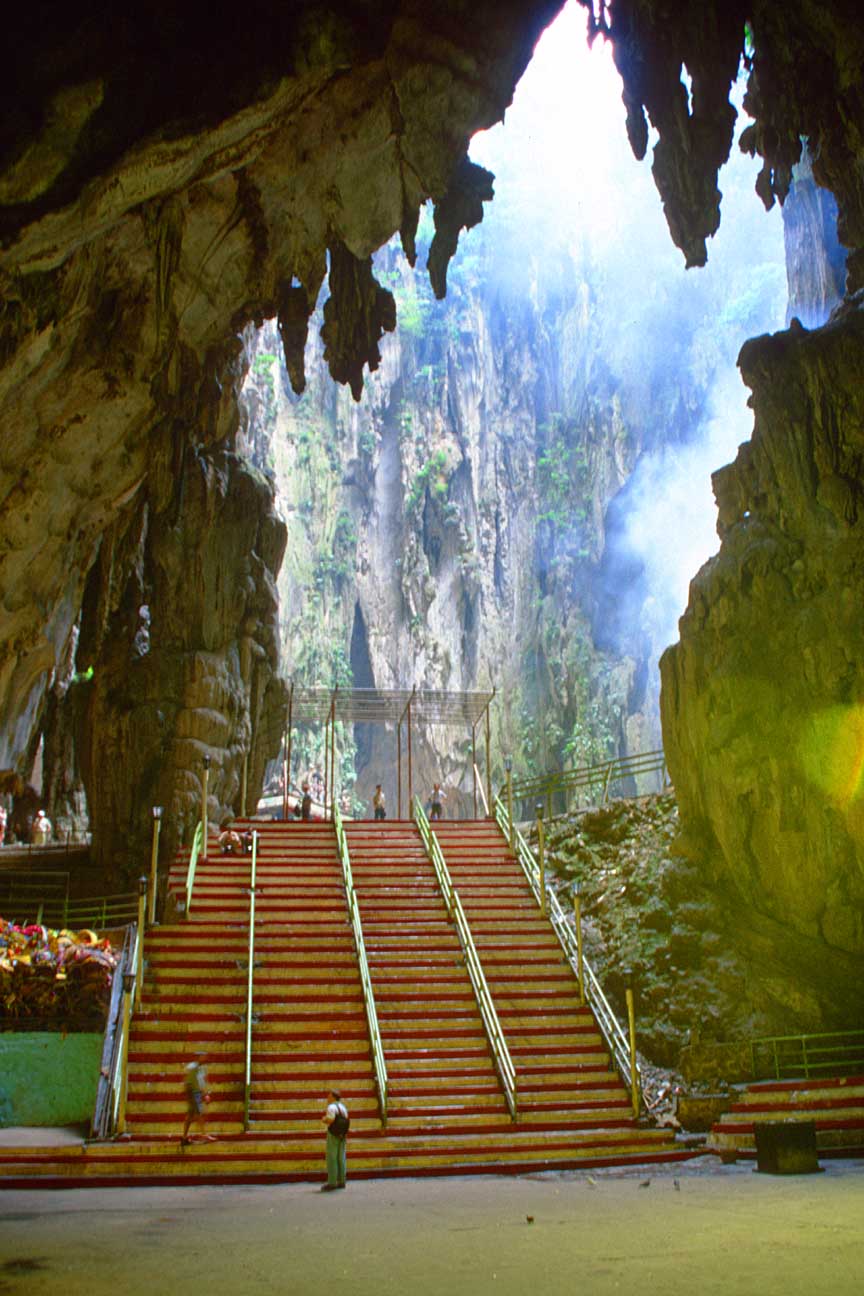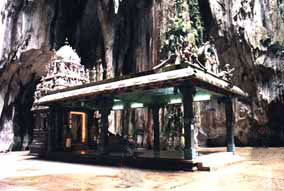 Batu Caves (Tamil: பத்து மலை), adalah bukit batu kapur, yang mempunyai satu siri gua dan kuil gua, di daerah Gombak, 13 kilometer (8 batu) utara Kuala Lumpur, Malaysia. Ia mengambil namanya dari Sungai Batu atau Batu River, yang mengalir melepasi bukit. Batu Caves juga merupakan nama kampung berdekatan. Gua ini adalah salah satu kuil Hindu yang paling popular di luar India, khusus kepada Dewa Subramaniam. Ia merupakan titik tumpuan Hindu semasa perayaan Thaipusam di Malaysia. Sejarah Batu kapur yang membentuk di Batu Caves dikatakan terhasil sekitar 400 juta tahun dahulu. Beberapa pintu masuk gua telah digunakan sebagai tempat perlindungan oleh orang asli Temuan yang turut mengaitkan Batu Caves dengan kisah Si Tenggang. Pada awal 1860, penduduk Cina mula menggali pupuk dr tahi burung di gua tersebut untuk benih sayur-sayuran patch mereka. Walau bagaimanapun, mereka menjadi terkenal hanya selepas kawasan bukit batu kapur telah direkodkan oleh pihak berkuasa penjajah termasuk Daly dan Syers serta Naturalist Amerika, William Hornaday pada tahun 1878.  Tugu Dewa Murugan Batu Caves telah diperkenalkan sebagai tempat ibadat oleh K. Thamboosamy Pillai, seorang pedagang India[2].Beliau mendapat inspirasi daripada pintu masuk utama gua yang berbentuk 'vel' dan dan mendapat inspirasi untuk membina sebuah kuil untuk Dewa Murugan dalam gua tersebut. Pada tahun 1890, Pillai, yang juga telah mengasaskan Kuil Sri Maha Mariamman, Kuala Lumpur, telah memasang Arca Dewa Murugan yang masih terdapat sehingga sekarang di 'Temple Cave' Tapak Keagamaan Di ketinggian hampir 100 Meter dari dasar laut, kompleks kuil Batu Caves terdiri daripada tiga gua utama dan beberapa gua kecil. Gua yang terbesar dikenali sebagai Cathedral Cave atau Gua Kuil. Didalamnya tedapat sebuah kuil Hindu.Untuk sampai ke gua ini pengunjung perlu menaiki 272 anak tangga. Pada kaki bukit adalah dua lagi gua kuil, iaitu Gua Galeri Seni(Art Gallery Cave) dan Gua Muzium (Museum Cave), kedua-duanya penuh denga arca-arca dan lukisan Hindu.Kompleks ini telah diubahsuai dan dibuka sebagai Cave Villa pada tahun 2008. Arca-arca dan lukisan di gua ini menggambarkan kisah kemenangan kemenangan Dewa Murugan ke atas Soorapadam. Gua Ramayana terletak ke kiri kompleks kuil Batu Caves. Dalam perjalanan ke Gua Ramayana, terdapat Tugu Dewa Hanuman yang setinggi 50 kaki serta sebuah kuil yang didedikasikan untuk Dewa Hanuman. Gua Ramayana menggambarkan cerita Rama dalam cara kronik sepanjang dinding dan tidak teratur. Sebuah patung 42,7 meter (140 kaki) tinggi Dewa Muruga telah dilancarkan pada Januari 2006, setelah mengambil 3 tahun untuk membina. Ia adalah patung Tuhan Muruga yang tertinggi di dunia. Pentadbiran Batu Malai Sri Subramaniar Temple diuruskan oleh Lembaga Pengurusan Kuil Sri Maha Mariamman Devasthanam, yang juga menguruskan Kuil Sri Maha Mariamman, Kuala Lumpur dan Kuil Kortumalai Pillaiya. Lembaga ini juga melakukan peranan Perunding Agama Hindu kepada Kerajaan Malaysia dalam menentukan kalendar Hindu tahunan.
|
|
54
 Bagus |
6
 Marah |
11
 Terkejut |
3
 Sedih |
6
 Lawak |
14
 Bosan |

Anonymity

Anonymity

Anonymity

Anonymity

Anonymity

Anonymity

Anonymity

Anonymity

Anonymity

Anonymity

Anonymity

Anonymity

Anonymity

Anonymity

Anonymity

Anonymity

Anonymity

Anonymity

Anonymity

Anonymity

Anonymity

Anonymity

Anonymity

Anonymity

prettyuglybabe posted on 17-2-2014 03:51 PM
duduk dekar-dekat pun tak pernah naik batu cave ni.. teringin nak gi sekali
cef_gango posted on 17-2-2014 03:59 PM
umh aku dkt je tp xpnh pg, klu nk pg jum pakat n forumer wt lawatan kt sana ok?

ogata posted on 17-2-2014 04:38 PM
aku entah kebetulan atau suratan...
tiap kali aku drop or tunggu kawan aku di stesen batu caves k ...
 mgkin ko xkuat semangat. hehe baru nak ajak ko buat lawatan.
mgkin ko xkuat semangat. hehe baru nak ajak ko buat lawatan.cef_gango posted on 17-2-2014 04:48 PM
oh kau mcm aku jugak. dlu deman panas smpai masuk hospital. pastu mak aku ckp aku ada ejek2 bnda t ...
ogata posted on 17-2-2014 04:53 PM
mana ada ejek..nak cakap benda tak baik pun xada.....
tengok macam biasa je..tunggu kawan i macam ...
 jum g sunway nak?
jum g sunway nak?cef_gango posted on 17-2-2014 06:17 PM
dah mcm msuk scream park sunway dah ko ni jum g sunway nak?


Batu Caves Budget Hotel is situated near by to Batu Caves which has a series of caves and cave temples, located in Gombak district, 13 kilometres (8.1 mi) north of Kuala Lumpur, Malaysia. It takes its name from the Sungai Batu or Batu River, which flows past the hill.
Batu Caves is also the name of the nearby village. The cave is one of the most popular Hindu shrines outside India, dedicated to Lord Murugan. It is the focal point of Hindu festival of Thaipusam in Malaysia which attracts over 1.5 million pilgrims yearly, making it one of the largest annual gatherings anywhere in the world.
History
 The limestone forming Batu Caves is said to be around 400 million years old. Some of the cave entrances were used as shelters by the indigenous Temuan people (a tribe Orang Asli). As early as 1860, Chinese settlers began excavating guano for fertilising their vegetable patches. However, they became famous only after the limestone hills were recorded by colonial authorities including Daly and Syers as well as American Naturalist, William Hornaday in 1878.
The limestone forming Batu Caves is said to be around 400 million years old. Some of the cave entrances were used as shelters by the indigenous Temuan people (a tribe Orang Asli). As early as 1860, Chinese settlers began excavating guano for fertilising their vegetable patches. However, they became famous only after the limestone hills were recorded by colonial authorities including Daly and Syers as well as American Naturalist, William Hornaday in 1878.
Batu Caves was promoted as a place of worship by, an Indian trader. He was inspired by the ‘vel’-shaped entrance of the main cave and was inspired to dedicate a temple to Lord Muruga within the caves.
In 1891, Pillai, who also founded the Sri Mahamariamman Temple, Kuala Lumpur, installed the murti (consecrated statue) of Sri Subramania Swamy in what is today known as the Temple Cave.
Since 1892, the Thaipusam festival in the Tamil month of Thai (which falls in late January/early February) has been celebrated there. Wooden steps up to the Temple Cave were built in 1920 and have since been replaced by 272 concrete steps. Of the various cave temples that comprise the site, the largest and best known is the Temple or Cathedral Cave, so named because it houses several Hindu shrines beneath its 100 m vaulted ceiling.
Festivals
Batu Caves serves as the focus of the Hindu community’s yearly Thaipusam Tamil festival. It has become a pligrimage site for not only Malaysian Hindus, but Hindus worldwide from countries such as India, Australia and Singapore.
A procession begins in the wee hours of the morning on Thaipusam from the Sri Mahamariamman Temple, Kuala Lumpur leading up to Batu Caves as a religious undertaking to Lord Muruga lasting eight hours. Devotees carry containers containing milk as offering to Lord Muruga either by hand or in huge decorated carriers on their shoulders called ‘kavadi’.
The kavadi may be simple wooden arched semi-circular supports holding a carrier foisted with brass or clay pots of milk or huge, heavy ones which may rise up to two metres, built of bowed metal frames which hold long skewers, the sharpened end of which pierce the skin of the bearers torso. The kavadi is decorated with flowers and peacock feathers imported from India. Some kavadi may weigh as much as a hundred kilograms. After a bath in the nearby Sungei Batu (Rocky River), the devotees wend their way to the Temple Cave and with remarkable endurance they climb the flights of stairs to the temple in the cave.
Devotees use the wider centre staircase while worshippers and onlookers throng up and down those balustrades off on either side. When the kavadi bearer arrives at the foot of the 272 step stairway leading up to the Temple Cave, the devotee has to make the arduous climb against gravity- against the press of the bustling masses. Priests attend to the kavadi bearers. Consecrated ash is sprinkled over the hooks and skewers piercing the devotees flesh before they are removed. No blood is shed during the piercing and removal. In 2007, the festival attracted more than 1.5 million pilgrims, making it one of the largest gatherings in history.








ADVERTISEMENT